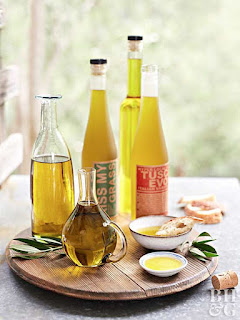Things You Didn't Know About Extra Virgin Olive Oil
1. Olive oil isn't lower in calories
This is a pretty common misconception (we’ve certainly fallen for it before), but light or extra-light olive oil doesn’t have fewer calories than regular extra virgin olive oil—both have about 120 calories per tablespoon. Most olive oil substitutes won't be lower in calories either. Instead, the “light” part of the name refers to the ration of extra virgin olive oil to refined olive oil. Light olive oil has less extra virgin olive oil, and since extra virgin olive oil is what gives your oil its distinct flavor, light olive oils will have a more neutral taste and a “lighter” flavor.
2. Fancy containers will make your olive oil spoil faster
If you’ve ever watched a cooking show, you’ve probably seen a chef use a fancier bottle with a special pour-top for their olive oil. But while these bottles look nice and might make drizzling easier (you've probably seen them at restaurants, too), they’ll also make your olive oil spoil quicker if you actually store it in one. Olive oil should be stored in a cool, dark place, usually in its original bottle, though dark glass and tin bottles are the best for storage.
3. If you'er not using it quickly, it's probably past it's prime
A lot of people tend to think of olive oil as a pantry staple that doesn’t really go bad, but that’s also not the case. Even if you’re storing it correctly, you should use up an open bottle within a month or two of opening it. Exposure to oxygen, light, and heat will all make your oil turn rancid more quickly, so proper storage is key. Rather than an expiration or “best by” date, look for a harvest date when you’re at the store. This is the date that the olives were harvested and made into oil; most olive oil is best when used within a year of the harvest date (and it doesn’t get better with age, so use it up!).
4. Cloudy olive oil is safe to use
Don’t bypass olive oils at the store just because they have a cloudy appearance. This doesn’t mean that the oil has gone bad—it usually means that it’s an unfiltered olive oil, where the sediment and olive pulp wasn’t removed when it was being processed. Some people think unfiltered olive oils taste better, so you may want to give them a try. Just use them quick—unfiltered olive oil will also go bad quicker. Filtered olive oil can also look cloudy if it’s been chilled, but it also hasn’t gone bad; just leave it out at room temperature, and it will clear up in no time.
5. The color doesn't impact the flavor or quality
Another common misconception about olive oil is that a darker color indicates a higher quality. The color has no impact on flavor, and good olive oils can be any color from a pale yellow to a darker green. Green olive oils are usually made from unripe, green olives (that’s where the color comes from), while oils made from riper olives usually the more common pale or deep yellow colors.
6. It's completely safe to cook with
You may have heard that olive oil is best for making dressings and drizzling on bread but isn’t great for sautéing or roasting. But in reality, olive oil is completely safe to cook and bake with. Just do your best to avoid the smoke point—this won’t make your olive oil toxic, as several scary myths claim, but it will start to lose some of its nutrients and make the flavor less-than tasty. Most extra virgin olive oils will start to smoke when it’s heated to 374°F, while light olive oil will start smoking at 470°F. We still wouldn’t recommend it for high-heat cooking, like frying, because the flavor will be off, but there’s nothing unsafe about it.

No comments:
Post a Comment